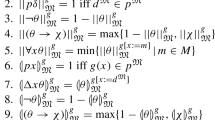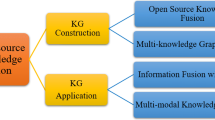Abstract
A typed category theory is proposed for the abstract description of knowledge and knowledge processing. It differs from the traditional category theory in two directions: all morphisms have types and the composition of morphisms is not necessary a morphism. Two aspects of application of typed category theory are discussed: cones and limits of knowledge complexity classes and knowledge completion with pseudo-functors.
Similar content being viewed by others
References
Shannon C E. A mathematical theory of communication. The Bell System Technical Journal, 1948, 27: 379–423, 623–656.
Petri C A. Kommunikation mit automaten [Dissertation]. Darmstadt, 1962.
Chongyi Yuan. Petri Nets: Principles and Applications. Electronics Press, 2005.
Feigenbaum E A, McCorduck P. The Fifth Generation, Artificial Intelligence and Japan's Computer Challenge to the World. Addison-Wesley, 1983.
Arbib M A, Manes E G. Arrows, Structures, and Functors—The Categorical Imperative. Academic Press, 1975.
MacLane S. Categories for the Working Mathematician. Springer-Verlag, Second Edition, 1998.
Category Theory. Wikipedia, the free encyclopedia, 2005. http://en.wikipedia.org/wiki/category_theory
Quillian M R. Semantic Memory. Semantic Information Processing. Minsky M (ed.), Cambridge: MIT Press, 1968.
Simmons R F. Semantic Networks: Their Computation and Use for Understanding English Sentences. Computer Models of Thought and Language, Shank R C, Colby K M (eds.), San Francisco: Freeman, 1973.
F Sowa John. Conceptual Structures: Information Processing in Mind and Machine. Reading, MA: Addison-Wesley, 1984.
Conceptual graph working document. Ref. No. ISO/JTC1/ SC32/WG2N000, http://www.jfsowa.com/cg/cgstand.htm, 2001.
Chen P P. The entity-relationship model-toward a unified view of data. ACM Trans. Database Systems, 1976, 1: 9–36.
OWL Web Ontology Language Overview. W3C Recommendation, February 10, 2004, http://www.w3.org/TR/2004/Rec-owl-features-20040210/.
Allen J F. Maintaining knowledge about temporal intervals. Communications of the ACM, November 1983, 26(11): 832–843.
Allen J F. Towards a general theory of action and time. Artificial Intelligence, 1984, 23(2): 123–154.
Rendell D A, Cui Z, Cohn A G. A spatial logic based on regions and connection. International Conference on Knowledge Representation and Reasoning, 1992, pp.165–176.
Fiadeiro José L. Categories for Software Engineering. Springer-Verlag, 2005.
Johnson M et al. Entity-relationship-attribute designs and sketches. Theory and Application of Category Theories, 2002, 10(3): 94–112.
Burstall R M, Goguen J A. Putting theories together to make specifications. IJCAI-77, 1977, pp.1045–1058.
Johnson M, Dampney C N G. On category theory as a (meta) ontology for information systems research. In Proc. the Int. Conf. Formal Ontology in Information Systems, 2001, pp.59–69.
Barwise J, Seligman J. Information Flow. Cambridge University Press, 1997.
Gogic G, Kautz H, Papadimitriou C, Selman B. The comparative linguistics of knowledge representation. IJCAI-95, Montreal, 1995, pp.862–869.
Kent R E. IFF Foundation Category. p.16.
Ruqian Lu. Looking for a mathematical theory of knowledge. In Proc. KEST 2004, Beijing, 2004, pp.3–8.
Author information
Authors and Affiliations
Corresponding author
Additional information
Supported by the National Basic Research 973 Program of China under Grant Nos. 2001CCA03000, 2001AA113130, 2001CB312004 and the Major Program of the National Natural Science Foundation of China under Grant No.
A preliminary version of this paper appeared in Proc. KEST 2004, Beijing
Rights and permissions
About this article
Cite this article
Lu, RQ. Towards a Mathematical Theory of Knowledge^*. J Comput Sci Technol 20, 751–757 (2005). https://doi.org/10.1007/s11390-005-0751-4
Received:
Revised:
Issue Date:
DOI: https://doi.org/10.1007/s11390-005-0751-4




